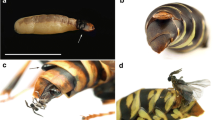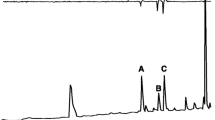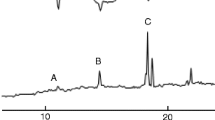Abstract
Females of the potato aphid Macrosiphum euphorbiae exhibit typical calling behavior, with virgin female oviparae raising their back legs off the substrate to release sex pheromone from glands on the tibia. Airborne collections from calling oviparae were analyzed by GC and GC-MS to determine if, like the majority of aphids examined to date, they produced (1R,4aS,7S,7aR)-nepetalactol (1) and (4aS,7S,7aR)-nepetalactone (2). Both components were present and produced in ratios that varied with age from 4:1 to 2:1. The relative stereochemical configurations of these components were determined by GC-coinjection of the aphid-derived sample with synthetic standards on both HP-1 and DB-Wax GC columns. The absolute stereochemical configuration of the nepetalactol (determined from approximately 15 μg of material in an air entrainment sample) was determined as (1R,4aS,7S,7aR)-1 by derivatization of the aphid sample with (S)-(+)-α-methoxy-α-(trifluoromethyl)phenylacetyl chloride (Mosher's acid chloride) to generate a diastereoisomer that was compared to synthetic samples by NMR spectroscopy and GC. In bioassays in the wind tunnel, M. euphorbiae males responded to potato plants with oviparae but not to unattacked plants or those infested with parthenogenetically reproducing apterae. In no-choice laboratory bioassays, the same level of male response was observed to virgins and to the 3:1–5:1 synthetic blends of nepetalactol (1):nepetalactone (2). However, the time taken to reach the source was significantly less to virgin females than to the synthetic pheromone blends. In all cases, males walked rather than flew to the source. Males showed lower responses to a 1:1 synthetic mixture and did not respond to either of the components when presented alone. Under field conditions, few M. euphorbiae males were captured in traps baited with different ratios of the synthetic pheromone. Possible reasons for the different responses under laboratory and field conditions are discussed.
Similar content being viewed by others
REFERENCES
Alyokhin, A., Sewell, G., and Groden, E. 2002. Aphid abundance and potato virus Y transmission in imidacloprid-treated potatoes. Am. J. Potato Res. 79:255–262.
Blackman, R. L. and Eastop, V. F. 2000. Aphids on the World's Crops: An Identification and Information Guide, 2nd edn. Wiley, New York, p. 250.
Boo, K. S., Choi, M. Y., Chung, I. B., Eastop, V. F., Pickett, J. A., Wadhams, L. J., and Woodcock, C. M. 2000. Sex pheromone of the aphid, Tuberocephalus momonis, and optimal blends for trapping males and females in the field. J. Chem. Ecol. 3:601–609.
Campbell, C. A. M., Dawson, G. W., Griffiths, D. C., Pettersson, J., Pickett, J. A., Wadhams, L. J., and Woodcock, C. M. 1990. Sex attractant pheromone of damson-hop aphid Phorodon humuli (Homoptera, Aphididae). J. Chem. Ecol. 16:3455–3465.
Dawson, G. W., Griffiths, D. C., Janes, N. F., Mudd, A., Pickett, J. A., Wadhams, L. J., and Woodcock, C. M. 1987. Identification of an aphid sex pheromone. Nature 325:614–616.
Dawson, G. W., Griffiths, D. C., Merritt, L. A., Mudd, A., Pickett, J. A., Wadhams, L. J., and Woodcock, C. M. 1990. Aphid semiochemicals—A review, and recent advances on the sex pheromone. J. Chem. Ecol. 16:3019–3030.
Dawson, G. W., Griffiths, D. C., Merritt, L. A., Mudd, A., Pickett, J. A., Wadhams, L. J., and Woodcock, C. M. 1988. The sex pheromone of the greenbug, Schizaphis graminum. Entomol. Exp. Appl. 48:91–93.
Dawson, G. W., Janes, N. F., Mudd, A., Pickett, J. A., Wadhams, L. J., and Williams, D. J. 1989. The aphid sex pheromone. Pure Appl. Chem. 61:555–558.
Dawson, G. W., Pickett, J. A., and Smiley, D. W. M. 1996. The aphid sex pheromone cyclopentanoids: Synthesis in the elucidation of structure and biosynthetic pathways. Bioorg. Med. Chem. 4:351–361.
Eisenbach, J. and Mittler, T. E. 1980. An aphid circadian rhythm: Factors affecting the release of sex pheromone by oviparae of the greenbug, Schizaphis graminum. J. Insect Physiol. 26:511–515.
Foster, S. P., Denholm, I., and Thompson, R. 2003. Variation in response to neonicotinoid insecticides in peach-potato aphids, Myzus persicae (Hemiptera: Aphididae). Pest Manage. Sci. 59:166–173.
Gabrys, B. J., Gadomski, H. J., Klukowski, Z., Pickett, J. A., Sobota, G. T., Wadhams, L. J., and Woodcock, C. M. 1997. Sex pheromone of cabbage aphid Brevycoryne brassicae: Identification and field trapping of male aphids and parasitoids. J.Chem. Ecol. 23:1881–1891.
Goldansaz, S. H. and McNeil, J. N. 2003. Calling behaviour of the potato aphid Macrosiphum euphorbiae oviparae under laboratory and field conditions. Ecol. Entomol. 28:291–298.
Guldemond, J. A., Dixon, A. F. G., Pickett, J. A., Wadhams, L. J., and Woodcock, C. M. 1992. The role of host-plant odour and sex pheromones in mate recognition in the aphid Cryptomyzus, pp. 119–121, in Proceedings of the 8th International Symposium on Insect-Plant Relationships. Kluwer Acad. Pub., Dordrecht, The Netherlands.
Guldemond, J. A., Dixon, A. F. G., Pickett, J. A., Wadhams, L. J., and Woodcock, C. M. 1993. Specificity of sex pheromones, the role of host plant odour in the olfactory attraction of males, and mate recognition in the aphid Cryptomyzus. Physiol. Entomol. 18:137–143.
Hardie, J., Holyoak, M., Nicolas, J., Nottingham, S. F., Pickett, J. A., Wadhams, L. J., and Woodcock, C. M. 1990. Aphid sex pheromone components: Age-dependent release by female and species-specific male response. Chemoecology 1:63–68.
Hardie, J., Nottingham, S. F., Dawson, G. W., Harrington, R., Pickett, J. A., and Wadhams, L. J. 1992. Attraction of field-flying aphid males to synthetic sex pheromone. Chemoecology 3:113–117.
Hardie, J., Peace, L., Pickett, J. A., Smiley, D. W. M., Storer, J. R., and Wadhams, L. J. 1997. Sex pheromone stereochemistry and purity affected field catches of male aphids. J. Chem. Ecol. 23:2547–2554.
Hardie, J., Storer, J. R., Nottingham, S. F., and Peace, L. 1994. The interaction of sex pheromone and plant volatiles for field attraction of male bird-cherry aphid, Rhopalosiphum padi, pp. 1223–1230, in Brighton Crop Protection Conference—Pests and Diseases. British Crop Protection Council, Thornton Health, UK.
Hartfield, C. M., Campbell, C. A. M., Hardie, J., Pickett, J. A., and Wadhams, L. J. 2001. Pheromone traps for the dissemination of an entomopathogen by the damson-hop aphid Phorodon humuli. Bio. Sci. Technol. 11:401–410.
Hemingway, J., Field, L., and Vontas, J. 2002. An overview of insecticide resistance. Science 298:96–97.
Hooper, A. M., Donato, B., Woodcock, C. M., Park, J. H., Paul, R. L., Boo, K. S., Hardie, J., and Pickett, J. A. 2002. Characterization of (1R,4S,4aR,7S,7aR)-dihydronepetalactol as a semiochemical for lacewings, including Chrysopa spp. and Peyerimhoffina gracilis. J. Chem. Ecol. 28:829–851.
Kennedy, J. S., Day, M. F., and Eastop, V. F. 1962. A Conspectus of Aphids as Vectors of Plant Viruses. Commonwealth Agricultural Bureaux, London.
Lange, W. H. and Bronson, L. 1981. Insect pests of tomatoes. Annu. Rev. Entomol. 26:345–371.
Legendre, P. and Legendre, L. 1998. Numerical Ecology, 2nd English edn. Elsevier, Amsterdam, p. 853.
Lilley, R. and Hardie, J. 1996. Cereal aphid responses to sex pheromones and host-plant odours in the laboratory. Physiol. Entomol. 21:304–308.
Lilley, R., Hardie, J., Merritt, L. A., Pickett, J. A., Wadhams, L. J., and Woodcock, C. M. 1994/1995. The sex pheromone of the grain aphid, Sitobion avenae (Fab.) (Homoptera, Aphididae). Chemoecology 5/6:43–46.
Lilley, R., Hardie, J., Powell, W., and Wadhams, L. J. 1994. The aphid sex pheromone: A novel host location cue for the parasitoid Praon volucre, pp. 1157–1162, in Brighton Crop Protection Conference—Pests and Diseases. British Crop Protection Council, Thornton Health, UK.
Marsh, D. 1972. Sex pheromone in the aphid Megoura viciae. Nature 238:31–32.
McNeil, J. N. 1991. Behavioral ecology of pheromone-mediated communication in moths and its importance in the use of pheromone traps. Annu. Rev. Entomol. 36:407–430.
Metcalf, R. L. 1980. Changing role of insecticides in crop protection. Annu. Rev. Entomol. 25:219–256.
Moran, N. A. 1992. The evolution of aphid life cycles. Annu. Rev. Entomol. 37:321–348.
Pettersson, J. 1970. An aphid sex attractant. I. Biological studies. Entomol. Scan. 1:63–73.
Pettersson, J. 1971. An aphid sex attractant. II. Histological, ethological and comparative studies. Entomol. Scan. 2:81–93.
Pickett, J. A., Wadhams, L. J., and Woodcock, C. M. 1992. The chemical ecology of aphids. Annu. Rev. Entomol. 37:67–90.
Pickett, J. A., Wadhams, L. J., and Woodcock, C. M. 1994. Attempts to control aphid pests by integrated use of semiochemicals, pp. 1239–1246, in Brighton Crop Protection Conference—Pests and Diseases. British Crop Protection Council, Thornton Heath, UK.
Radcliffe, E. B. and Ragsdale, D. W. 2002. Aphid-transmitted potato viruses: The importance of understanding vector biology. Am. J. Potato Res. 79:353–386.
SAS. 1999. Version 8.2. SAS Institute Inc., Cary, NC.
Shands, W. A., Simpson, G. W., Muesebeck, C. F. W., and Wave, H. E. 1965. Parasites of potato-infesting aphids in northeastern Maine. Maine Agric. Exp. Stn. Tech. Bull. T-19: 77 pps.
Steffan, A. W. 1990. Courtship behaviour and possible pheromone spread by hindleg raising in sexual females of aphids (Homoptera: Aphididae). Entomol. Gen. 15:33–49.
Thieme, T. and Dixon, A. F. G. 1996. Mate recognition in the Aphis fabae complex: Daily rhythm of release and specificity of sex pheromones. Entomol. Exp. Appl. 79:85–89.
Author information
Authors and Affiliations
Rights and permissions
About this article
Cite this article
Goldansaz, S.H., Dewhirst, S., Birkett, M.A. et al. Identification of Two Sex Pheromone Components of the Potato Aphid, Macrosiphum euphorbiae (Thomas). J Chem Ecol 30, 819–834 (2004). https://doi.org/10.1023/B:JOEC.0000028434.19319.b4
Issue Date:
DOI: https://doi.org/10.1023/B:JOEC.0000028434.19319.b4




